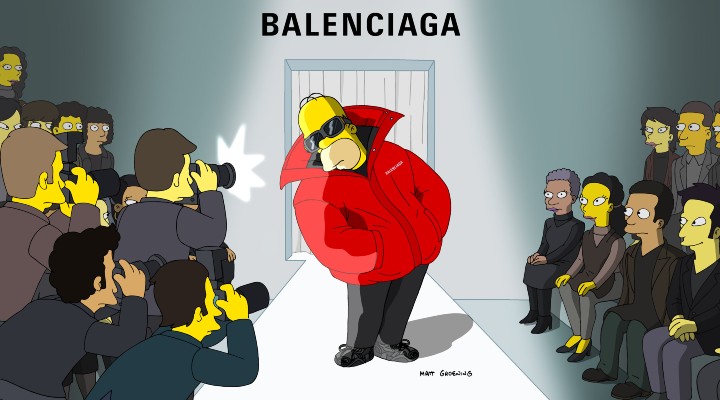Over the past six months, collab culture has taken a sharp turn. Balmain has teamed up with Barbie, Balenciaga launched its Spring collection with The Simpsons, while art collective Brain Dead dropped an entire line of streetwear devoted to fantasy tabletop role-play game Dungeons and Dragons. The cult of ‘cool’ has shifted further and further towards the fringe, with fashion brands seemingly trying to out-nerd one another. Whilst such collabs could be dismissed as novel-for-the-sake-o
e-of-novelty, there’s a lot more going on here. These collabs aren’t just a clash of aesthetics. They present a mashup of moods. Perhaps as a by-product of pandemic burnout or a calculated strategy to hack the social feed, 2022 is rejecting the world of the ‘serious’, and running headfirst into an anti-apologetic era of cringe.
Fashion notoriously sits on the precipice of cutting edge in retail, so when Roblox starts replacing runways, and train-watching takes centre stage in a Gucci campaign…it’s time to ask why.
Been there, collab’d that
In 2022, collaborations have become conventional. Pioneered by streetwear and luxury fashion labels, the marrying of brands is a tried and tested strategy to supercharge sales by binding two pre-existing fandoms into one. Yet as many experts have noted, 2021 was the year of power-couple collabs, characterised by big brand 1 x big brand 2 (think Gucci x Balenciaga, Supreme x Tiffany, Yeezy x Gap). While it was cool at the time, chucking an ‘x’ between two big brands has become a little bit…predictable.
The success of a collab relies on an element of cultural friction. When slapping two logos together becomes commonplace, that friction starts to wane. This is even more of a problem when algorithmic feeds like Instagram produce a harmonisation of tastes, making it harder for brands to stand out.
Exclusivity over empathy
Historically, ‘cringe’ has been a negative word associated with a visceral feeling of awkwardness or regret. Fast-forward to the TikTok era, and the word has been co-opted by a collective of people who go viral on TikTok as users vicariously share in their embarrassment. In total contrast to the smoothly curated feed of a perfectly posed influencer, a surge of content from users ‘exposing’ themselves via retelling of embarrassing anecdotes has driven over half a billion videos with the hashtag #cringetok.
Cringe is used as both adjective and noun, and points to a broader shift towards empathy, as users share moments, experiences, and passions that point to their most authentic selves. It is no coincidence that the most viral ‘cringetoks’ are posted by people without the privilege of beauty, wealth, or social cred. They have different body types, unusual hobbies, and unique stories to tell. For brands, this content presents a shift in the hierarchy of who deserves to be seen. TikTok’s ability to transform everyday people into viral stars overnight means the potential talent pool looks radically different to five years ago.
New-wave ‘cringe-fluencers’
The cult of cringe has led major brands like Gucci to move away from their previous top-tier influencers (think actor Jared Leto or rapper A$AP Rocky) towards someone like 21-year-old Londoner Francis Bourgeois, known for his wildly unencumbered train-watching videos. Bourgeois’s content is peak cringe. He has no qualms strapping a Go-pro to his head and sharing footage of himself squealing and tearing up in an absurd display of locomotive rapture. While his behaviour does not immediately scream luxury, it is a uniquely perfect articulation of Gucci’s latest strategic push to tell stories of “eccentric exploration” with The North Face.
Much like the spirit of online meme culture, this new era of collabs has an affinity for all things non-serious. It has given permission for an exclusive brand like Balenciaga to launch its latest collection in collaboration with The Simpsons, releasing mini-episodes across social channels that immortalise their designs in cartoon form. Essential to this strategy is a tension of taste – an exclusive European fashion empire clashing loudly against a historically ‘low-brow’ American cartoon. And because The Simpsons would’ve been laughed out of the brainstorm room 10 years ago, its community of fans now present immense and untapped buying power. In November last year, newly released Simpsons NFTs tripled in value and sold out in minutes. Such cultural friction points supercharge brand visibility and inject a unique (and very Gen Z) element of playfulness back into marketing.
Flipping the category script
Subcultural clashes are also the easiest way to enter new retail verticals. In Nike’s Minecraft collab, the brand ventures deeper into gaming, while Under Armour used Sesame Street to venture into youth mentorship. Rather than stay in the fashion lane, Balmain creative director Olivier Rousteing leaned into the shame he experienced playing with Barbie dolls as a child. Building on the cultural zeitgeist of authentic play, he doubled down to launch a 50-piece Barbie-inspired unisex collection that reflects “how good it feels to be free with yourself without being judged”. The toy-fashion hybrid collection spawned a 186sqm pop-up Barbie store, complete with fairy-floss machines and three one-of-a-kind Barbie NFTs to be auctioned off online.
Amidst endless scrolls on social feeds, it is those unique and highly unexpected cultural friction points that will cut through retail clutter, and pioneer new moments and products for consumers to enjoy. Brands wanting to enter this new collab era should look to:
Get familiar with the fringe especially those with active and untapped fandoms Embrace eclectic ambassadors and look for co-creation opportunities Break category conventions to dial up friction points
Louis Vuitton creative director Virgil Abloh famously said, “Collaboration is not a punchline…I only collaborate with the best in each category.” The cult of cringe invites brands to platform those creators and subcultures that are the very best at authenticity and individuality.

